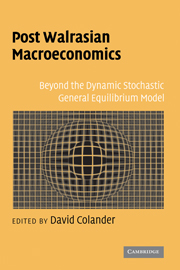Book contents
- Frontmatter
- Contents
- List of Contributors
- Foreword by Alan Kirman
- Introduction
- PART I WHERE WE ARE IN MACRO AND HOW WE GOT THERE
- 1 Episodes in a Century of Macroeconomics
- 2 Post Walrasian Macroeconomics: Some Historic Links
- 3 The Problem of Time in the DSGE Model and the Post Walrasian Alternative
- 4 Who Is Post Walrasian Man?
- PART II EDGING AWAY FROM THE DSGE MODEL
- PART III LEAPING AWAY FROM THE DSGE MODEL
- PART IV LETTING THE DATA GUIDE THEORY
- PART V POLICY IMPLICATIONS
- Bibliography
- Index
2 - Post Walrasian Macroeconomics: Some Historic Links
Published online by Cambridge University Press: 02 December 2009
- Frontmatter
- Contents
- List of Contributors
- Foreword by Alan Kirman
- Introduction
- PART I WHERE WE ARE IN MACRO AND HOW WE GOT THERE
- 1 Episodes in a Century of Macroeconomics
- 2 Post Walrasian Macroeconomics: Some Historic Links
- 3 The Problem of Time in the DSGE Model and the Post Walrasian Alternative
- 4 Who Is Post Walrasian Man?
- PART II EDGING AWAY FROM THE DSGE MODEL
- PART III LEAPING AWAY FROM THE DSGE MODEL
- PART IV LETTING THE DATA GUIDE THEORY
- PART V POLICY IMPLICATIONS
- Bibliography
- Index
Summary
In many ways the developments in the last 50 years in macro – Keynesian economics, the IS–LM model, and the New Classical Revolution – were deviations from Classical thought that took seriously the complexity of the macroeconomy, and did not see the macroeconomy as controllable. The Post Walrasian work discussed in this volume is beginning to take that complexity seriously, and is beginning to struggle with developing a theoretical foundation for a complex-system view of the macroeconomy. This chapter discusses aspects of the history of macroeconomics, providing some historical links for Post Walrasian work, and explores why that earlier work did not succeed.
I begin with a brief review of Classical macroeconomics and I discuss the Neoclassical–NeoKeynesian synthesis, the New Classical Revolution, and the DSGE synthesis, and then I conclude with a brief discussion of why Post Walrasian work is more closely tied to Classical economics than is the DSGE synthesis.
CLASSICAL MACROECONOMICS
The consideration of macro issues has been around since the beginning of economics, but the actual corpus of work fitting into a course entitled macroeconomics began only in the 1950s, reflecting an evolution of thinking in macro that was closely tied to the Keynesian revolution. Before the Keynesian revolution, a formal macroeconomic theory was considered too complicated to deal with; it pushed the chain of reasoning beyond what the empirical evidence or the analytic structure could support.
- Type
- Chapter
- Information
- Post Walrasian MacroeconomicsBeyond the Dynamic Stochastic General Equilibrium Model, pp. 46 - 69Publisher: Cambridge University PressPrint publication year: 2006
- 3
- Cited by



